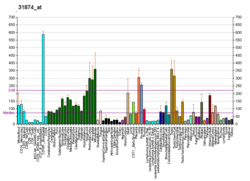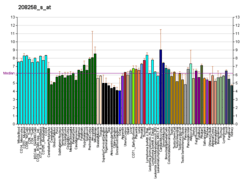GAS2L1
GAS2-like protein 1 is a protein that in humans is encoded by the GAS2L1 gene.[5][6][7][8]
The protein encoded by this gene, a member of the GAS2 family, is similar in sequence to the mouse protein Gas2, an actin-associated protein expressed at high levels in growth-arrested cells. Expression of the mouse Gas2 gene is negatively regulated by serum and growth factors. Three transcript variants encoding two different isoforms have been found for this gene.[8]
References
- 1 2 3 GRCh38: Ensembl release 89: ENSG00000185340 - Ensembl, May 2017
- 1 2 3 GRCm38: Ensembl release 89: ENSMUSG00000034201 - Ensembl, May 2017
- ↑ "Human PubMed Reference:".
- ↑ "Mouse PubMed Reference:".
- ↑ Zucman-Rossi J, Legoix P, Thomas G (Mar 1997). "Identification of new members of the Gas2 and Ras families in the 22q12 chromosome region". Genomics. 38 (3): 247–54. doi:10.1006/geno.1996.0625. PMID 8975699.
- ↑ Goriounov D, Leung CL, Liem RK (Feb 2003). "Protein products of human Gas2-related genes on chromosomes 17 and 22 (hGAR17 and hGAR22) associate with both microfilaments and microtubules". J Cell Sci. 116 (Pt 6): 1045–58. doi:10.1242/jcs.00272. PMID 12584248.
- ↑ Brancolini C, Bottega S, Schneider C (Jul 1992). "Gas2, a growth arrest-specific protein, is a component of the microfilament network system". J Cell Biol. 117 (6): 1251–61. doi:10.1083/jcb.117.6.1251. PMC 2289493. PMID 1607387.
- 1 2 "Entrez Gene: GAS2L1 growth arrest-specific 2 like 1".
Further reading
- Maruyama K, Sugano S (1994). "Oligo-capping: a simple method to replace the cap structure of eukaryotic mRNAs with oligoribonucleotides". Gene. 138 (1–2): 171–4. doi:10.1016/0378-1119(94)90802-8. PMID 8125298.
- Suzuki Y, Yoshitomo-Nakagawa K, Maruyama K, et al. (1997). "Construction and characterization of a full length-enriched and a 5'-end-enriched cDNA library". Gene. 200 (1–2): 149–56. doi:10.1016/S0378-1119(97)00411-3. PMID 9373149.
- Weinmann AS, Yan PS, Oberley MJ, et al. (2002). "Isolating human transcription factor targets by coupling chromatin immunoprecipitation and CpG island microarray analysis". Genes Dev. 16 (2): 235–44. doi:10.1101/gad.943102. PMC 155318. PMID 11799066.
- Strausberg RL, Feingold EA, Grouse LH, et al. (2003). "Generation and initial analysis of more than 15,000 full-length human and mouse cDNA sequences". Proc. Natl. Acad. Sci. U.S.A. 99 (26): 16899–903. doi:10.1073/pnas.242603899. PMC 139241. PMID 12477932.
- Ota T, Suzuki Y, Nishikawa T, et al. (2004). "Complete sequencing and characterization of 21,243 full-length human cDNAs". Nat. Genet. 36 (1): 40–5. doi:10.1038/ng1285. PMID 14702039.
- Gerhard DS, Wagner L, Feingold EA, et al. (2004). "The status, quality, and expansion of the NIH full-length cDNA project: the Mammalian Gene Collection (MGC)". Genome Res. 14 (10B): 2121–7. doi:10.1101/gr.2596504. PMC 528928. PMID 15489334.
- Olsen JV, Blagoev B, Gnad F, et al. (2006). "Global, in vivo, and site-specific phosphorylation dynamics in signaling networks". Cell. 127 (3): 635–48. doi:10.1016/j.cell.2006.09.026. PMID 17081983.
This article is issued from
Wikipedia.
The text is licensed under Creative Commons - Attribution - Sharealike.
Additional terms may apply for the media files.






